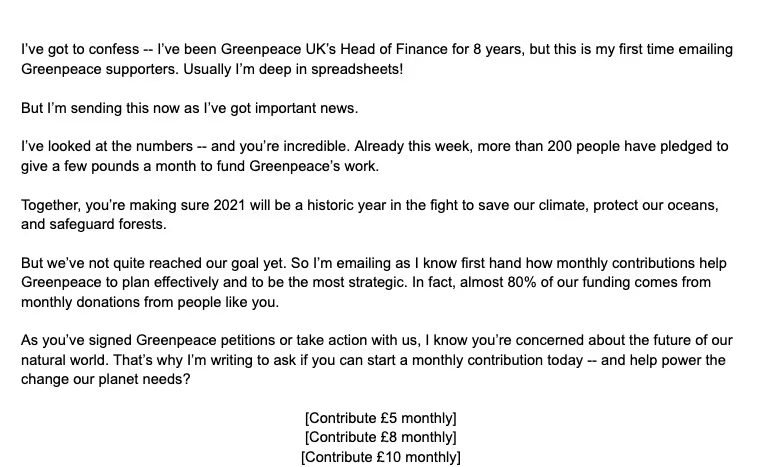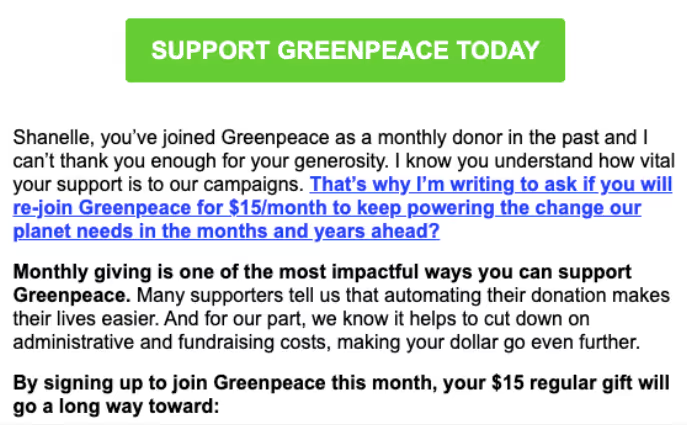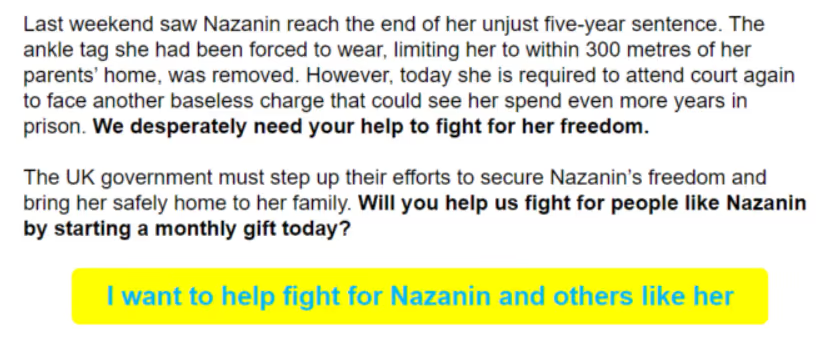Fundraising: How Wasp tracked 250+ meetings in 98 days to get to the oversubscribed round
At Demo Day Wasp had solid traction, but no monetization yet. Learn how they chased "no's" and got to an oversubscribed round.
Nonprofit email fundraising campaigns are a powerful way to raise funds while nurturing relationships in your network.
Estimates suggest email accounted for 14% of all online revenue for nonprofits in 2022.
However, nonprofit fundraising emails are tricky to get right. And the definition of “right” is frustratingly subjective, depending on your organization type and target audience.
No need to worry – we’ve listed eight steps to successfully launch your next nonprofit email fundraising campaign.
<div class="anchor-wrapper"><div id="fundraising-email" class="anchor-target"></div></div>
A fundraising email is a message specifically created to gather donations from your audience. Like traditional outreach channels, email is a great method for educating your audience on your mission, recruiting volunteers, and asking for donations.
<div class="anchor-wrapper"><div id="email-fundraising-campaign" class="anchor-target"></div></div>
An email fundraising campaign is a series of marketing emails designed to contact donors on a large scale. These campaigns aim to connect with a network of hundreds, or even thousands, all in one go. Because of their low cost, they can be a powerful element of your fundraising strategy.
A strong email fundraising campaign includes strategic messages and personalization to ensure you’re targeting your donors effectively.
The key to a great email campaign is striking a balance between reaching as many people as possible and using a human touch to nurture a strong connection. People need to feel the humanity in your mission before they hit the “donate” button.
Planning and executing a successful email fundraising campaign consists of:
Automation is crucial – you need your campaign running while you’re focusing your attention on the important tasks that keep your nonprofit running.
<div class="anchor-wrapper"><div id="good-idea-nonprofit" class="anchor-target"></div></div>
Traditional methods like making calls, walking door-to-door, sending direct mail (the good old fundraising letter), and other in-person fundraising events can be effective. However, they need vast amounts of time, volunteers, and money.
On the other hand, online fundraising – email fundraising, in particular – campaigns are highly effective as well as affordable and scalable.
Let’s get into that in depth.
Nonprofit organizations are typically trying to stretch their resources to achieve maximum impact.
As your nonprofit grows, you’ll need to reach increasingly more donors, which means you need solutions that scale while also allowing your team of employees and volunteers to focus on projects and responsibilities outside of fundraising.
Email fundraising campaigns help you manage resources efficiently and save money without pulling resources away from other activities. Setting up an email fundraising campaign is quick and straightforward, allowing workers to set it in motion – and then get back to their core work.
Your staff won’t always have specific technical skills, and training needs to be streamlined and efficient.
Automatic email campaigns have a shallow learning curve and only require a little time to create the base framework. Build templates and cadences, set the automation, and click “go.”
The best part is that this process scales indefinitely. Once your team learns how to set up email campaigns, they'll be able to quickly create them for fundraising, newsletters, donor updates, and more.
Historically, connections with potential donors have happened at events or other in-person opportunities. Nowadays, those people can be difficult to reach offline.
In the past twenty years, online shopping has increased by 300%. As a reflection of where and how people are spending their money, this indicates that they’re increasingly likely to make purchases and donations online. As a result, email fundraising campaigns are a powerful method of meeting donors where they’re at - and where they have their wallets out.
In addition to raising money, email fundraising campaigns can also promote brand awareness, educate, nurture, and mobilize volunteers.
Here’s an example from the World Wildlife Fund:

It begins with a little fun fact: “Today is Global Tiger Day.”
Then, it continues into more educational content about their mission and impact:

Taking the time to talk about the natural habitat of these tigers is a great way to engage their audience, connect with them more deeply, and make the donation request more poignant.
<div class="anchor-wrapper"><div id="8-steps-fundraising" class="anchor-target"></div></div>
Now that you understand how email can help your organization, follow these 8 steps to create an effective email fundraising campaign:
Before diving into the email campaign itself, check if your mailing list is updated. This will ensure your emails are reaching as many relevant supporters as possible.
First, ensure that all your subscribers have given you their permission to receive emails from your organization.
Permission is achieved through:
These opt-in and opt-out processes strengthen your database, ensure you're compliant with privacy requirements, and improve your lead generation by creating an email list of highly relevant contacts.
Once you’ve set up your opt-in and opt-out practices, remove any contacts that have gone stale from your email list or don't meet the above requirements. If they haven’t opened an email in a year or so, they probably aren’t going to be donating any time soon.
Email tracking tools can help you identify these contacts.

In Streak, you can create a filter to find people who haven’t engaged with an email in a long time (we’d say about a year) and quickly remove cold leads.
The last step in bolstering your database is adding contacts that you want to reach out to – but haven’t contacted yet. This is the time to use your detective skills to find prospective donors’ email addresses, or add emails collected from recent events.
The same email won’t suit everyone on your mailing list.
Segmenting your fundraising email campaign helps you create more relevant emails to engage and personally connect with your donors.
Common ways to segment your email recipients include:
Let’s take that last one as an example.
Because of vastly different budgets, goals, and relationships, corporate versus private donors will require totally different email campaigns.
For instance, a corporate fundraising email might mention similar campaigns that the business has previously supported or how supporting your organization fits into their corporate social responsibility mission.
Ideally, you’ll plan a different email sequence for each significant segment.
Now that you’ve segmented donors, it’s time to plan a sequence for each one.
Different segments will require different personalization to engage them effectively.
For instance, long-time donors should receive emails that use familiar, grateful language to maintain the relationship. You may want to offer some data about the impact their donations have made, and how they can continue to drive change at your organization.
Supporters who have never donated should receive emails educating them about your mission and encouraging them to take the leap into making a contribution.
Let’s look at two examples from the global campaigning network Greenpeace:

This email segment is aimed at supporters who have signed petitions and received newsletters but never made a donation. The sender addresses the support the person has given but stresses that they need more help.
Next, let’s look at an email segment sent to a recipient who has donated in the past:

An email segment targeting previous donors will mention gratitude for their history of donations and ask if they’d be willing to restart their contributions.
Personalizing email segments will grab your audience’s attention with relevant information and drive them to act faster.
A successful mass email campaign to each segment will include:
These two factors drive your supporters to take action more than any other factor.
Of course, they need to open the email to see your story, which means you must grab your donors’ attention and attract their clicks with a stellar subject line.
Here are a few types of creative subject lines for fundraising emails:
Great email subject lines for fundraising start by trying a handful of these examples, then proceeding to A/B test them so you can iterate on subject lines that work and cross the others off your list.
Now that the reader has clicked the email – what’s the story inside?
You want to show your potential donors that their donations will make a difference, and your email content is your chance to get creative by demonstrating this.
Here are a few best practices for creating a great story for your fundraising emails:
Let’s take a look at a great example of “short and sweet” with great imagery and formatting from charity: water:

In this example, charity: water focuses on the positive impact of a contribution to paint a picture that the potential donor can feel good about, rather than focusing solely on the problem. It helps them visualize the impact of their support.
Keep in mind that urgent words and imagery can help get much-needed funds to your organization, but make sure emotional content helps your mission by inspiring potential donors to contribute.
A call-to-action (CTA) is the phrase that asks your supporters to take action and support your cause. The call to action in a fundraising email will link your audience to the donation landing page.
Having just one CTA in your email will make it clear what you'd like the recipient to do and how they can make the most impact. It’s easy to get carried away with links to “be a volunteer” or “follow us on Facebook” – but you don’t want the donor to get overwhelmed.
Here’s a good example of a CTA from Amnesty International:

Your call to action should be clear and concise, so it’s understandable but urgent to spur donations. It should also be specific so the potential donor knows what their money is going towards.
Optimize your campaign strategy by trying out different CTAs and testing which ones work best with link tracking. This will give you powerful insights into which CTAs drive the most donations.
Once they’ve clicked the all-too-important “donate” button, make sure they don’t have any hiccups when they pull their wallet out.
A few best practices for donation pages will help your supporters complete their transactions and may even encourage them to increase their donations or become regular contributors. They include:
A mobile-friendly donation page may be more important than you think – in 2021, 28% of online contributions to nonprofits came from a mobile device.
Now, let’s take a look at a simple yet effective donation page at World Wildlife Fund:

WWF makes it easy to choose different styles of donation, such as monthly or one-time, as well as varying amounts of money to personalize your gift. These options increase the “fundraising appeal.”
They also make monthly donations the default option when you land on the page. This is by design, as monthly donations account for 28% of all online revenue for nonprofits.
Your audience wants, loves, and needs to see the good they’re doing.
A great way to show your donors the impact of their help is by building an automated sequence into your email fundraising campaign to thank them for supporting your cause and remind them of the impact they’re making.
Here’s an example from the Australian Red Cross:

Your donors want to know they’re making a difference and that you recognize it.
This type of sequence can include sharing case studies and stories or giving statistics. Real data shows your audience in clear, concrete terms what they helped you achieve.
A thank you message goes a long way and might be all it takes for your organization to stay at the top of your audience’s giving list.
Tracking your email fundraising campaign gives you valuable data on how your campaign performs – and how you can improve it.
Receiving hard data on email open rates, click-through rates, and response rates provides solid, campaign-specific information to repeat what works and improve areas that aren’t performing well.
Once you’re tracking data from your email campaigns, start A/B testing various aspects of your campaign, like subject line, email copy, imagery, and CTA.
For example, you could A/B test various subject lines to see which approaches get the highest open rates among your email list.
Managing fundraising email campaigns with a continuous-improvement mindset helps you track performance at both an individual email and overall campaign level. It also improves your understanding of your campaign’s success, which leads to better outcomes and more consistent donations.
<div class="anchor-wrapper"><div id="launch-successful-campaign" class="anchor-target"></div></div>
An email fundraising campaign is one of your organization’s most effective channels for collecting donations and nurturing supporters.
The keys to success include:
Don’t forget the most important takeaway: continuous improvement through tracking campaign performance.
To learn more about using data to boost a campaign’s performance, brush up on important tracking metrics and see how you can compare campaign results.
Build and launch your email campaign today with Streak.
